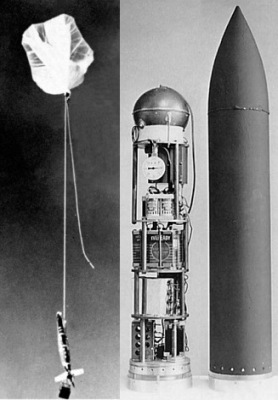Purpose of the flight and payload description
The so-called ROCKOON (Rocket-Balloon) technique enabled small rockets to reach higher altitudes by launching them from a stratospheric balloon. The balloon would ascend to approximately 70,000 feet, where the rocket was fired using an onboard timer, a pressure switch, or telecommand. This innovative method was first employed in 1952 by Dr. James Van Allen, who was working at the State University of Iowa at the time.
The primary advantage of the rockoon combination was that it allowed the rocket to bypass the denser, lower layers of the atmosphere without expending its own propulsion energy. This resulted in a higher achievable apogee. However, the technique had a limitation: once released, the balloons could not be steered, making it impossible to precisely predict the rocket's launch direction or impact area. To address this safety concern, all rockoon missions were conducted from small vessels operating in open waters. This approach offered an additional benefit, as the ships could adjust their position to create "zero wind conditions," ideal for balloon launches.
The initial rockoon launches utilized a high-performance, small rocket known as DEACON. Developed in 1947 by Allegany Ballistics Laboratory for the Navy Bureau of Ordnance, the Deacon was originally designed to carry a 50-pound instrument payload to an altitude of approximately 20 miles. The rocket had no internal controls or movable surfaces and relied on fin-based arrow stabilization at its rear. Propulsion was provided by a JATO X220 solid propellant rocket motor. The Deacon measured 12.3 feet in length, had a diameter of 6.5 inches, and featured a fin span of 38.9 inches. When launched from a balloon at an altitude of around 70,000 feet, it could achieve speeds of approximately 3,000 mph and altitudes exceeding 60 miles.
The purpose of this flight was to obtain an absolute measurement of the total intensity of charged primary cosmic rays, extending to the lowest feasible value of magnetic rigidity. The SCIENTIFIC PAYLOAD was housed in the nose section of the rocket, which was pressurized, approximately conical in shape, detachable, and had a volume of about 2.5 cubic feet. This payload included a spherical ion chamber at the top, followed by a box containing the associated electronic circuits located behind the pressure gauge. The next three decks were allocated for batteries, while the lower deck contained the telemetry transmitter. An image of the setup can be seen on the left above.
A small rocket-firing gondola -equipped with a timer, barometric pressure switch, and firing batteries- was suspended from the rocket's tail fins by a lightweight cord. This design ensured that the rocket would separate cleanly once it was fired.
Details of the balloon flight
Balloon launched on: 9/4/1952
Launch site: USCGC Eastwind (WAGB 279) anclado en la Bahia de Baffin entre Groenlandia y el NE de Canada (Lat. 77.18º N - Lon. 70.22º O)
Balloon launched by: General Mills Inc.
Balloon manufacturer/size/composition: Zero Pressure Balloon Winzen - 73 ft
Flight identification number: GMI-963
End of flight (L for landing time, W for last contact, otherwise termination time): 9/4/1952
Landing site: Payload no recoverable
The balloon was launched on September 4th, 1952 from the deck of the U.S Coast Guard vessel Eastwind, sailing at coordinates 77º11'N - 71º13'W. After reaching float altitude of 8.1 miles, the rocket was fired succesfully and achieved an apogee of 39.8 miles.
External references
- Cosmic-Ray Intensity above the Atmosphere at High Latitudes Physical Review, Vol 99 Nº 1 p. 198
- Deacon rocket launches log Jonathan McDowell's website
- Final Report Project 85006 General Mills - 1953
- Upper Atmosphere Research Report Number 21. Summary of Upper Atmosphere Rocket Research Firings Naval Research Lab., Feb. 1954
497If you consider this website interesting or useful, you can help me to keep it up and running with a small donation to cover the operational costs. Just the equivalent of the price of a cup of coffee helps a lot.


